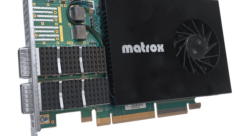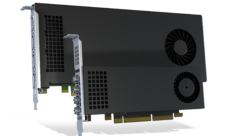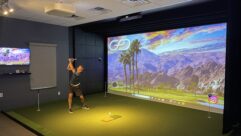
Video Review: Epson PowerLite Pro G5350NL
Jan 1, 2009 12:00 PM,
By Jeff Sauer
An installation-oriented projector that combines networking with quality features.

Epson has been a leader in integrating projectors into digital infrastructures for almost a decade, with wired and wireless networking capabilities that afford both remote administration and digital-image connectivity. One of Epson’s newest PowerLite Pro models, the G5350NL, combines that networking with an affordable, yet feature-laden medium-venue installation model that boasts high brightness, excellent contrast, accurate color, and the flexibility of five lens options.
The native XGA PowerLite Pro G5350NL uses three 0.8in. LCD panels, and it comes in a 15lb. chassis designed for installation. There are no unit-top controls, but rather a small set of only-if-necessary manual controls next to the inputs on the rear of the unit. The clear intent is that installers will set up the projector using the presenters’ wireless remote that comes with the projector. The remote includes six dedicated input buttons, full trackball/mouse capabilities, page up/down functions, volume control, freeze frame, AV mute, a laser pointer, and complete menu access and navigation.
As one would expect from an installation-oriented projector, the G5350NL also includes both horizontal and vertical lens shift. To keep the price down, Epson has gone with manual lens-shift knobs that are located on the top of the chassis. Focus and zoom are also manual. I tested the unit with the standard lens option ($1,399), but there are four other lenses that work with the G5350NL: two middle-throw lenses, a long-throw lens, and a rear-projection lens. These lenses range from 0.78:1 for the rear-projection lens up to 7.2:1 for the long-throw.
Epson has also included both horizontal and vertical keystone correction, as well as corner correction for off-angle projection. Epson calls it “Quick Corner,” and it gives the installer the ability to tug at each of the four corners of the image individually should the room not allow for a direct-angle projector. However, as with similar functionality from other makers, there’s rarely anything quick about the process of getting an off-angle image just right. Still, it’s a valuable tool in situations where it’s needed.
The G5350NL has a plethora of color-mode presets to assist with setup. Presentation, sRGB, and Theater modes are common and straightforward. Yet Epson adds a black-and-white Text mode for very high ambient light, an over-saturated color Photo mode, a similarly vivid Sports mode for entertainment installations, a Game mode that prioritizes grayscale range, a Blackboard mode that re-adjusts for projection onto a green chalkboard, and a Custom mode that affords individual color adjustments.
For connectivity, the G5350NL has two computer channels via either two 15-pin D-sub ports (as well as a 15-pin monitor output) or one 15-pin and one 5-BNC RGBHV that also can input YPrPb or YcrCb component video. There’s also an S-Video and an RCV and BNC composite input. Interestingly, while there is no DVI input, Epson does include an HDMI input for digital video. A detachable rear-panel cover can hide all ports — including ones for 9-pin RS-232, wired remote, USB, an SD card, and Ethernet — and keep installations clean.
Video Review: Epson PowerLite Pro G5350NL
Jan 1, 2009 12:00 PM,
By Jeff Sauer
An installation-oriented projector that combines networking with quality features.
It’s those last three ports that set the G5350NL apart and cater to digital-savvy installations. Admittedly, none is all that foreign; indeed, USB inputs are fairly common these days, and SD cards are starting to appear a little more often. Yet Epson has been including digital inputs in projectors since 2000, and that’s made the Ethernet port and wireless options in the G5350NL mature. Ethernet functionality isn’t all that rare, but for most other manufacturers, it still has been limited to remote monitoring and administrative functions. Indeed, that type of administrative oversight has obvious appeal for targeted, high-volume users, and the G5350NL supports it. The G5350NL, however, goes beyond remote administration to afford projecting images over a wired or wireless network as well using Epson’s EasyMP software. You can set up the optional wireless card to function in Ad Hoc point-to-point mode or Access Point mode to allow broader network access to the projector.
A PRETTY PICTURE TOO
I measured every bit of Epson’s claim of 5000 lumens of brightness and even a little more (5032 ANSI lumens) in Presentation mode. Brightness goes down in different color modes (about 20 percent in sRGB, 25 percent in theater, etc.), but that is certainly to be expected. The 3LCD consortium has also been pushing a new measure called “color brightness,” which is the sum of brightness measurements on individual red, green, and blue screens. Ideally that sum should be the same as white-screen brightness, and LCD technology certainly gets closer than single-chip DLP. For the G5350NL, Epson claims the same 5000 lumens, but I measured it at a still very respectable 4658 ANSI lumens.
The rest of the G5350NL’s fundamentals are equally impressive. I measured a contrast ratio of 830:1. That’s a little shy of Epson’s 1000:1 mark, but mine was measured straight in Presentation without any brightness or contrast alterations. Epson also achieved an extremely good 93.9-percent brightness uniformity and very consistent color temperature across a range of grayscale values in sRGB mode. I did see a drop of about 500K near the top of the white range, but only in Presentation mode.
Epson’s color reproduction was also extremely good. It’s the most consistent boast of 3LCD technology over DLP, which isn’t always the case. With the G5350NL, Epson backs it up with very solid, if slightly oversaturated, primaries (only red hinted away from center, a bit toward green) and near-rock-solid secondaries.
Picture quality is also very good. With XGA sources, even test patterns were crisp and sharp. Higher-resolution sources forced some minor moiré effects and some softness around sharp text, but that’s almost inevitable, and the G5350NL rates very high compared to similar projectors.
Overall, Epson has cut very few corners (aside from the manual lens shift) with the G5350NL. Image quality is extremely good, as are the connectivity options, so it’s easy to like the G5350NL as a straight high-brightness installation projector — especially given the excellent contrast and good color. Yet, with the addition of the Epson’s integration of IT features, the G5350NL also offers considerable advantages in remote administration and wireless and wired networking that would make it a workhorse in business and educational environments.
Video Review: Epson PowerLite Pro G5350NL
Jan 1, 2009 12:00 PM,
By Jeff Sauer
An installation-oriented projector that combines networking with quality features.
PRODUCT SUMMARY
- Company: Epson
www.epson.com - Product: PowerLite Pro G5350NL
- Pros: Affordable installation projector, solid high brightness, excellent color.
- Cons: Lens shift is manual rather than powered to lower cost.
- Applications: Business and educational environments.
- Price: $6,098 (without lens)
SPECIFICATIONS
- Resolution: XGA (1024×768)
- Brightness: 5000 ANSI lumens
- Contrast: 1000:1 full on/off
- Native resolution: XGA (1024×768)
- Configuration: Three 0.8in. LCD panels
- Light source: One 275W UHE lamp (rated up to 3000 hours)
- Lens options: Five options; throw ratios from 1.3:1 to 7.2:1, plus 0.78:1 rear projection
- Zoom (standard lens): 1.82:1, manual F1.64-2.5, f=21.27mm-37.93mm
- Screen size (standard lens): 30in.-300in. diagonal
- Throw ratio (standard lens): 1.3-2.4:1
- Lens shift: ± 50 vertical, ±10 horizontal (manual)
- Keystone: ± 40 vertical, ±20 horizontal
- Loudspeakers: 7W monaural
- Dimensions: 18.5″;×5.9″×13.2″ (W×H×D)
- Weight: 15lbs.
- Warranty: Three years parts and labor, 90 days on lamp










